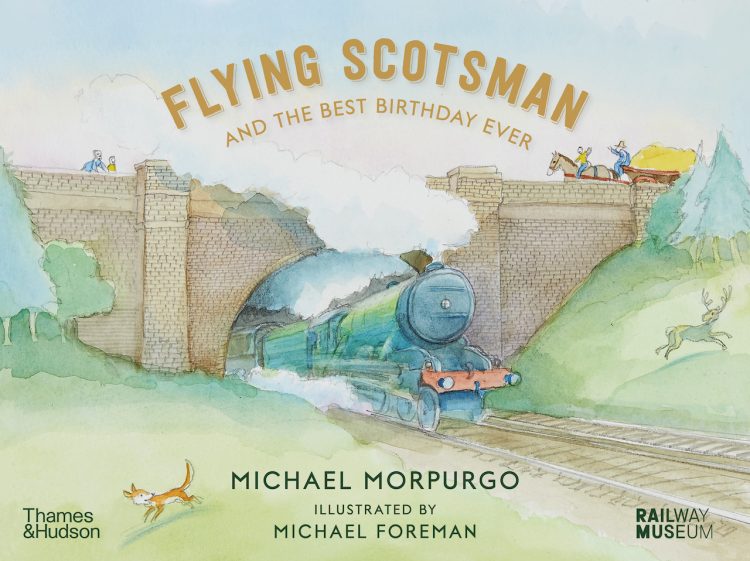It was 100 years ago today, Friday, 24th February 2023 that Flying Scotsman, the world’s most famous steam locomotive, set off on its first journey from its birthplace at Doncaster Works.
Flying Scotsman is now a national treasure and a star attraction for the National Railway Museum in York, where it is a working museum exhibit.

To mark today’s centenary, UK Poet Laureate Simon Armitage has released a new poem, The Making of Flying Scotsman, which pays homage to the celebrity engine as a feat of British design and engineering that has inspired a love of rail in generations of families and become synonymous with the golden age of rail travel.
Simon Armitage, commenting about the inspiration behind his new work, said: “Flying Scotsman is a poem. I just had to write it down.”
Simon’s poem, The Making of Flying Scotsman, is now on display as part of a new exhibition, Flying Scotsman: 100 Years, 100 Voices, at the National Railway Museum, that opened two weeks and celebrates the legacy of the locomotive through the lives it has touched.
Flying Scotsman has recently had a fresh coat of paint, and today it made a fleeting appearance at Edinburgh Waverley station where Simon Armitage read his poem whilst dancers from the Royal Scottish Country Dance Society performed ‘The Flying Scotsman’, devised by Hugh Thurston in 1966. A performance from the Celtic rock band, the Red Hot Chilli Pipers, rounded off the event.
Also announced today is a series of new Scottish events, including two main line rail tours and a visit to a heritage railway, details of these and the rest of Flying Scotsman’s centenary events can be found at https://www.railwaymuseum.org.uk
The Flying Scotsman centenary programme has been generously supported by Hornby Hobbies (Lead Sponsor) and has also been made possible thanks to the National Heritage Memorial Fund.
Flying Scotsman was designed by Sir Nigel Gresley and was the first locomotive to be built by the newly formed London and North Eastern Railway, and was named in 1924 after the daily 10am London King’s Cross to Edinburgh Waverley service. After withdrawal from British Rail in 1963 it entered preservation and toured the USA, Canada, and Australia.
A campaign spearheaded by the National Railway Museum was launched in 2004 to save Flying Scotsman for the nation and amassed the support of thousands, confirming its status as a national treasure. The appeal to keep the locomotive in Britain was supported by a £1.8 million grant from the National Heritage Memorial Fund, and its restoration was funded with the help of a Heritage Lottery Fund grant of £275,000.
Anyone unable to view Flying Scotsman on its centenary tour can still experience the locomotive through exhibitions including Flying Scotsman: 100 Years, 100 Voices, Flying Scotsman VR.
Collectable memorabilia is also available from the Science Museum shop, including a Flying Scotsman centenary train set; a £2 coin from The Royal Mint, featuring Flying Scotsman in vivid colour, which is a rarity on £2 coins as the last coloured £2 coin was released over 20 years ago; and a new children’s book by bestselling author Michael Morpurgo, Flying Scotsman and the Best Birthday Ever, which tells the story of a little girl called Iris who dreams of being a train driver when she grows up.

Judith McNicol, Director of the National Railway Museum, said: “Edinburgh Waverley is a fitting location to mark the centenary of the world’s most famous express passenger locomotive. It was here that Flying Scotsman completed its record-breaking, non-stop journey between London and Edinburgh in 1928 and Edinburgh is also the birthplace of Sir Nigel Gresley, Flying Scotsman’s designer.
“Today, Flying Scotsman is an undoubted star of the National Railway Museum’s collection and is recognised around the world as a triumph of British ingenuity and engineering.
“Flying Scotsman will now spend the rest of the year travelling across the country to give people the chance to see the engine for themselves and to take part in this special anniversary, from free static displays to rail tours to the Centenary Festival at Locomotion.”
Eilish McGuinness, Chief Executive of the National Heritage Memorial Fund, added: “In 2004, we supported the National Railway Museum in acquiring the majestic Flying Scotsman and placing it in the care of the national collection to make it publicly accessible forever and we later contributed towards its preservation.
“That is why it is so wonderful to be celebrating its centenary in Edinburgh and knowing that this much-loved heritage icon will be seen right across the UK in the coming year, bringing joy and wonder to all!”
Alex Hynes, Managing Director of Scotland‘s Railway, continued: “Edinburgh Waverley was honoured to host a visit from Flying Scotsman on such a special occasion and our team has pulled out all the stops for this special occasion.
“The most famous steam locomotive in the world always draws a crowd. Visitors to Princes Street Gardens, just across the road from Waverley, will see a familiar Flying Scotsman theme when the world’s oldest Floral Clock blooms later this year too. Make sure to pop in to see it while on your way to the station.”
Simon Kohler, Marketing & Development Director of Hornby, said: “Quite a few years ago I managed to persuade my then CEO that Hornby should create a suite of tools that would allow us to produce as many variants of Flying Scotsmanas possible. Through these models, Hornby has had the privilege of forging a strong relationship with both the NRM and the Science Museum. We are proud and honoured to be part of Flying Scotsman’s centenary celebrations.”
To celebrate the 100th Birthday of Flying Scotsman, if you use code FS100 on the RailAdvent store, you will receive 10% off all of our Flying Scotsman gifts!






Responses
I believe that my grandad has driven the Flying Scotsman, his name was Sid Collins, ( my mum’s dad. )
Which parts of Flying Scotsman are 100 years old again?
Spoilsport!